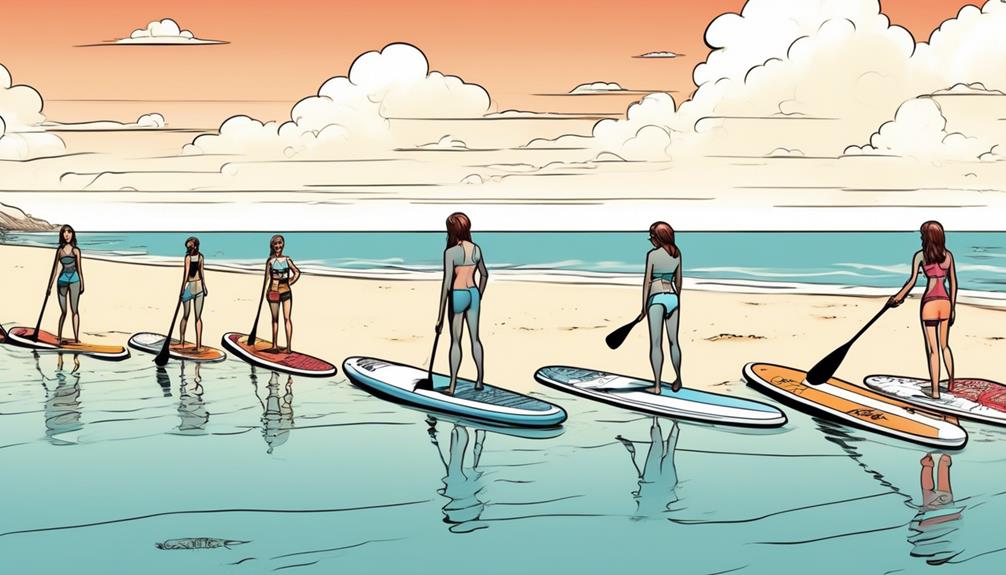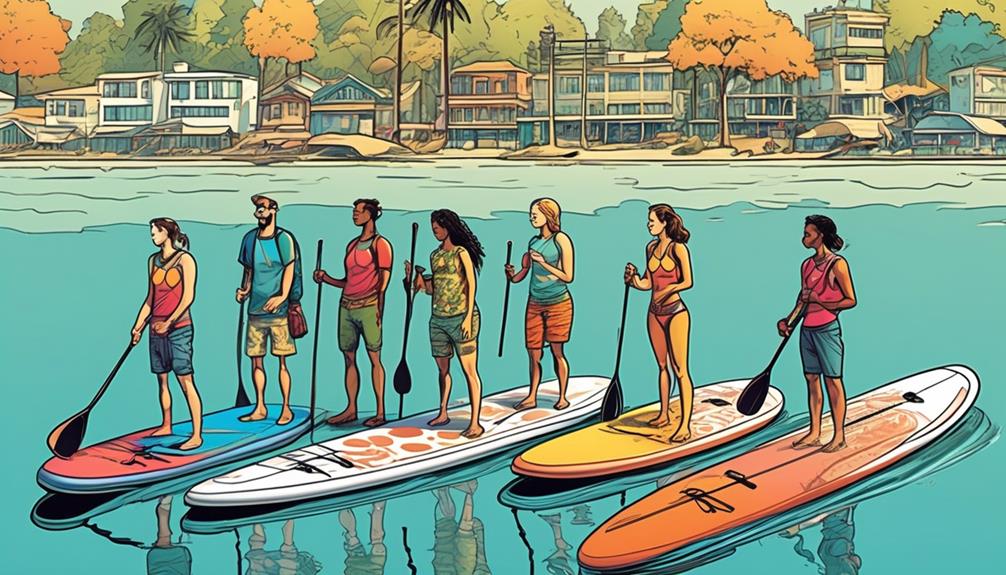In today's world where everyone's on the move, figuring out the right size inflatable paddle board can be a bit of a head-scratcher. You've got options ranging from 9-foot boards, perfect for a chill day on the lake, to 14-foot giants that'll have you cutting through ocean waves like butter. But hey, it's not just about how tall or long these boards are. Width, thickness, and volume are your true best friends when it comes to finding a board that won't let you down, especially when it comes to matching your body type and how skilled you are at paddling.
From my own spills and thrills on the water, I can tell you that whether you're a pro looking for your next big wave or a newbie trying not to fall in every two seconds, picking the right board size makes all the difference. You want to go for something that's not just going to float your boat but also make you feel like you've got this.
So, let me break it down for you with some real talk and data that'll help you make a choice you won't regret.
Key Takeaways
- When selecting an inflatable paddle board, consider the length, width, and thickness of the board to find the perfect balance for your specific needs and preferences.
- Beginners should opt for wider and longer boards for stability, while advanced paddlers require smaller and thinner boards for agility and speed.
- Your body type, including height and weight, should be taken into account when choosing the right board size. Taller individuals may need longer boards for stability, while heavier individuals should consider wider boards to support their weight.
- The right board size can significantly impact your paddleboarding experience, affecting stability, maneuverability, and overall performance. Prioritize your specific goals and avoid relying on trends or personal opinions when selecting a board.
Understanding Board Dimensions

So, you're in the market for an inflatable paddle board and feeling a bit overwhelmed by the options? You're not alone. Let me break it down for you, focusing on what really matters: length, width, and thickness. And trust me, getting these right can make or break your paddleboarding experience.
Let's start with length. Boards typically range from 10 to 12 feet. You might think longer boards are just for pros, but they're actually fantastic for beginners too, providing a stable ride. I've seen countless newbies thrive on a 12-footer, feeling more confident with every stroke.
Now, onto width. Are you aiming for a serene yoga session on the water? Or maybe you're a beginner seeking stability? A wider board, say around 32 inches or more, will be your best friend. However, if you're like me, chasing speed and sharp turns, a narrower board, closer to 30 inches, might be more your style. I've clocked significantly better times on narrower boards, cutting through water like a hot knife through butter.
Thickness is where it gets interesting. Most boards come in at 4 or 6 inches thick. If you're on the heavier side or planning to bring along some gear, a 6-inch board offers that extra buoyancy you'll need. I've loaded up my 6-inch thick board with camping gear without compromising performance. However, if you're lighter or a beginner, be wary. That extra thickness can make the board feel top-heavy and harder to balance on.
When I was hunting for my ideal inflatable paddle board, I wasn't swayed by the biggest or priciest tags. Instead, I looked at what I needed. For me, it was about speed and maneuverability, so I went narrower and didn't regret it. But I've also had mornings where I wished for a wider board for a chill yoga session.
It's not about what everyone else is buying or what the salesperson is pushing. It's about what you need. Do you want to glide smoothly and stably, soaking in the peace of the water? Or are you looking to slice through the waves, pushing your limits? Maybe you're after a floating yoga mat? Whatever your goal, understanding the balance between length, width, and thickness will guide you to the perfect board.
Matching Board Size to Skill Level
So, you're probably wondering how to pick the right paddleboard for your skill level, right? Let's get straight to the point – it's all about matching the board size with where you're at, skill-wise. I've been there, done that, and got the data to back up what works and what doesn't.
For beginners, let me lay it out for you. You want a board that's wider and longer. Why? Stability is your best friend here. Think about it – a study showed that boards with a width of around 32-34 inches and a length of about 10-12 feet drastically reduce the number of wipeouts for newbies. This isn't just about keeping you dry; it's about giving you the confidence to get back on without the fear of immediately falling off again. A board in this size range lets you focus on mastering the basics, like proper paddling technique and balance, without the added frustration.
Now, as you start feeling more confident and you're not constantly thinking about kissing the water, you're likely moving into the intermediate zone. Here's where things get a bit more interesting. You'll want to downsize slightly – boards that are a bit shorter and narrower offer that sweet spot between stability and maneuverability. We're talking a width of around 30-32 inches and a length of 9-11 feet. This isn't just me rambling; surveys from various paddleboarding communities have shown a clear preference for this size range among intermediates. It's enough to keep you stable but also allows you to start experimenting with speed and sharper turns.
For the advanced paddlers out there, you're looking at even smaller and thinner boards. This is where agility and speed become your primary focus. Advanced boards typically range in width from 26-30 inches and in length from 8-10 feet. These dimensions are perfect for those looking to push their limits, maybe throw in some tricks, or even tackle SUP surfing. It's a game of precision, and a smaller board gives you that control. Again, this isn't just me talking; competitive SUP athletes consistently choose boards within this range to maximize performance.
So, what's the takeaway here? It's simple – the right board can make or break your paddleboarding experience. But don't just take my word for it. Look at the data, understand the science behind stability and maneuverability, and consider what you want to achieve on the water. Whether you're just starting out or you're ready to ride waves like a pro, there's a board out there that's perfect for you.
Considering Your Body Type

When you're picking a board, whether it's for surfing, snowboarding, or skateboarding, it feels like you're trying to crack some secret code. But here's the deal: your body type plays a massive role in what kind of board you need. Let me break it down for you in a way that's both data-driven and straightforward.
Height and Weight matter, folks. Studies have shown, and yes, I'm talking about real, hard data here, that taller folks like us need longer boards. Why? Stability. It's all about not wiping out the moment you hit a wave or slope. And for those carrying a bit more, a wider board is your best friend. It's not just about fitting on the board; it's about ensuring it can support your weight without turning every ride into a battle against physics.
Now, let's talk Body Composition. If you're rocking a muscular build, you might've noticed that balancing on a tiny board feels like trying to stand on a pencil. That's because muscle mass changes your center of gravity. Opting for a slightly larger board can give you that extra bit of stability, making your ride smoother. And for the lean, mean, speed machines with leaner physiques, a narrower board can actually boost your speed and agility, making every turn crisp and every jump effortless.
Balance and Core Strength are huge too. If you've got a core that can rival a Greek god, you're in a good spot to handle smaller boards because you can manage the intricacies of balance much better. But if you're still working on not face-planting every five minutes, consider a wider board. It's like training wheels for boardsports; it gives you that extra stability so you can focus on improving without the constant fear of eating dirt.
So, why should you care? Well, if you're serious about not just participating but actually excelling in your sport, these aren't just tips; they're your playbook. Picking the right board isn't about following the crowd or buying what looks cool; it's about understanding how your unique body interacts with the physics of the sport. I've seen too many friends give up because they thought they just weren't cut out for it when, in reality, they were just on the wrong board.
Adventure Types and Board Selection
Choosing the right inflatable paddle board is all about matching it to your adventure vibes. Let's break it down with some real-world examples and data to ensure you're getting the best bang for your buck.
If you're like me and love the peace of a serene lake, you're gonna want a board that's longer and wider. Why? Because the stats show these designs offer stability and glide that's unbeatable for beginners or those of us who like to chill and soak in the scenery. Picture this: you're on a board with an increased surface area, which means you're spending more time enjoying the view and less time flailing about trying to stay upright. It's a no-brainer.
Now, for the adrenaline junkies among us who crave the thrill of surfing or taking on choppy waters, it's all about getting a shorter, more maneuverable board. This choice might mean sacrificing a bit of stability, but what you gain in agility is worth it. You'll be able to cut through waves and make those sharp turns like a pro. And let's not forget, these boards are built tough to handle the rough and tumble of coastal adventures.
For those of us who are in it for the long haul, touring or long-distance paddling demands a board that's a perfect blend of length for speed and enough width for stability. These boards are designed to let you cover more distance with less effort. Think about it – with the right board, you're not just paddling; you're cruising. It's about efficiency and endurance, allowing you to explore further and challenge yourself.
So, let's get down to brass tacks. You're likely a bit skeptical, thinking, 'Can the shape and size of a paddle board really make that much of a difference?' I'm here to tell you, absolutely. I've been on enough paddle boards to know that matching your board to your adventure isn't just some sales pitch; it's the key to unlocking the best experience on the water.
Making the right choice isn't just about the journey or the destination; it's about ensuring every outing is a perfect blend of both. And remember, the best part of any adventure is knowing you've got the right gear to tackle whatever comes your way.

